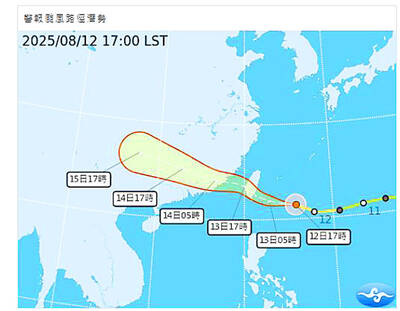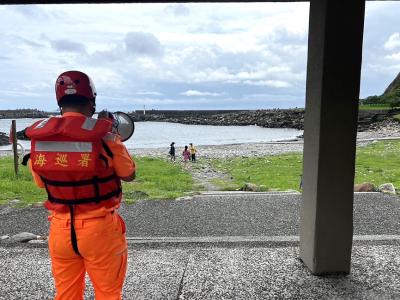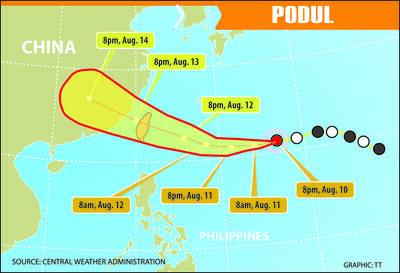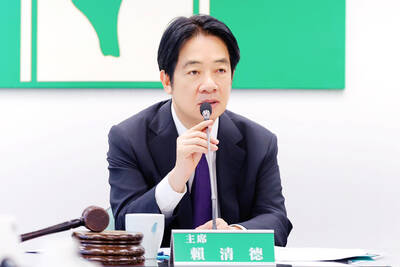Taiwan must tap into the global uncrewed aerial vehicle (UAV) market to obtain the capital necessary to develop a self-sufficient combat drone industry, experts said.
As defense analysts have speculated that China might invade Taiwan in 2027 or 2032, the nation must complete the decoupling of its drone supply chains from China in the next few years, Geosat Aerospace & Technology Inc (經緯航太科技) CEO Lo Cheng-fang (羅正方) said.
The ability to produce combat drones in wartime is crucial for Taiwan’s survival, but the nation’s UAV industry is still in its infancy, said Lo, who is also chairman of the Chiayi-based Asia UAV AI Innovation Application R&D Center.

Photo: CNA
The government should support the domestic industry to ensure Taiwan’s drone supply chains remain unbroken in the event of a military conflict with China, he said.
Drones are an integral part of President William Lai’s (賴清德) Five Trusted Industry Sectors, a category consisting of the semiconductor, artificial intelligence (AI), military, security and surveillance, and next-generation communications industries.
The administration aims to make Taiwan “the Asian hub of UAV supply chains for global democracies,” he said in his inaugural address on May 20.
These supply chains are made of about 40 Taiwanese firms that produce about a dozen drone models altogether, government data showed.
The Taiwanese drone sector was worth an estimated NT$2.86 billion (US$87.15 million) last year, while the global drone industry’s value is expected to reach US$80 billion by 2030.
Chiayi Economic Development Department Director Chiang Zhen-wei (江振瑋) said the global drone industry is split in two, with one side that uses Chinese supply chains and another that does not.
Because of those who have decoupled from China, there is a large opportunity for the domestic drone industry if it is prepared to seize it, he said.
The companies that are part of Chiayi’s drone center represent a complete UAV ecosystem, but the industry would still have to carve out an export market, Chiang said.
The operational costs of automated equipment capable of mass-producing reliable, quality components at scale cannot be funded by the domestic market alone, he added.
Despite Taiwan’s technical prowess, manufacturers cannot be expected to wade into the drone business just to supply domestic demand, said Lo Cheng-ying (駱正穎), a professor of mechanical engineering at National Formosa University.
“Becoming a part of the supply chain for democracies will be crucial going forward,” he said.
National Chung Cheng University strategic studies professor Lin Tai-ho (林泰和) said drones have significant battlefield applications and UAV manufacturing is an industry of ever-increasing importance strategically.
The Taiwanese UAV sector must develop an export market to supplement military contracts, especially as cheaper Chinese parts cannot be used, he said.
The Lai administration made the right call in pursuing the capability to manufacture drones independently of China’s supply chains, even if it is more expensive, Lin added.
Meanwhile, the government would play a key role in coordinating with its industrial partners, Hsuan Yuan Tech Co (璿元科技) CEO Chou Yu-tuan (周玉端) said.
The government must pay attention to industrial requirements in designing projects, as the current approach is leading to the proliferation of non-standard platforms with little commonality, which increases production difficulties and costs, he said.
The contract-issuing bodies of the government frequently demand changes to a project, such as its technical specifications and intended role, further adding to the chaos, he said.
Taiwan Swarm Innovation Inc (臺灣希望創新) CEO Li Chih-ching (李志清) said Washington is looking for allies to replace China in drone supply chains.
Taiwan has the technological capabilities to make drones, but Taiwanese systems are two to three times more expensive than their Chinese counterparts, he said.
Expanding into the global market would enable domestic UAV makers to benefit from the economy of scale and lower their prices to competitive levels, Li said.
However, the Taiwanese UAV sector is unlikely to be competitively priced compared with China, he said, adding the industry should concentrate on making drones for special applications for customers that cannot use systems that have Chinese parts.

GET TO SAFETY: Authorities were scrambling to evacuate nearly 700 people in Hualien County to prepare for overflow from a natural dam formed by a previous typhoon Typhoon Podul yesterday intensified and accelerated as it neared Taiwan, with the impact expected to be felt overnight, the Central Weather Administration (CWA) said, while the Directorate-General of Personnel Administration announced that schools and government offices in most areas of southern and eastern Taiwan would be closed today. The affected regions are Tainan, Kaohsiung and Chiayi City, and Yunlin, Chiayi, Pingtung, Hualien and Taitung counties, as well as the outlying Penghu County. As of 10pm last night, the storm was about 370km east-southeast of Taitung County, moving west-northwest at 27kph, CWA data showed. With a radius of 120km, Podul is carrying maximum sustained

Tropical Storm Podul strengthened into a typhoon at 8pm yesterday, the Central Weather Administration (CWA) said, with a sea warning to be issued late last night or early this morning. As of 8pm, the typhoon was 1,020km east of Oluanpi (鵝鑾鼻), Taiwan’s southernmost tip, moving west at 23kph. The storm carried maximum sustained winds of 119kph and gusts reaching 155kph, the CWA said. Based on the tropical storm’s trajectory, a land warning could be issued any time from midday today, it added. CWA forecaster Chang Chun-yao (張竣堯) said Podul is a fast-moving storm that is forecast to bring its heaviest rainfall and strongest

TRAJECTORY: The severe tropical storm is predicted to be closest to Taiwan on Wednesday and Thursday, and would influence the nation to varying degrees, a forecaster said The Central Weather Administration (CWA) yesterday said it would likely issue a sea warning for Tropical Storm Podul tomorrow morning and a land warning that evening at the earliest. CWA forecaster Lin Ting-yi (林定宜) said the severe tropical storm is predicted to be closest to Taiwan on Wednesday and Thursday. As of 2pm yesterday, the storm was moving west at 21kph and packing sustained winds of 108kph and gusts of up to 136.8kph, the CWA said. Lin said that the tropical storm was about 1,710km east of Oluanpi (鵝鑾鼻), Taiwan’s southernmost tip, with two possible trajectories over the next one

President William Lai (賴清德) yesterday criticized the nuclear energy referendum scheduled for Saturday next week, saying that holding the plebiscite before the government can conduct safety evaluations is a denial of the public’s right to make informed decisions. Lai, who is also the chairman of the Democratic Progressive Party (DPP), made the comments at the party’s Central Standing Committee meeting at its headquarters in Taipei. ‘NO’ “I will go to the ballot box on Saturday next week to cast a ‘no’ vote, as we all should do,” he said as he called on the public to reject the proposition to reactivate the decommissioned